Fuel Tank Replacement Pick-up - Side Tank
Removal Procedure
Tools Required
| • | J 34730-1A Fuel Pressure Gauge |
| • | J 39765 Fuel Sender Lock Nut Wrench |
- Disconnect the negative battery cable.
- Relieve the fuel system pressure. Refer to Fuel Pressure Relief .
- Drain the fuel from the tank. Refer to Fuel Tank Draining .
- Raise the vehicle. Refer to Lifting and Jacking the Vehicle in General Information.
- Disconnect the fuel tank filler neck hose (2) from the fuel tank.
- Disconnect the fuel tank vent hose (3) from the fuel tank.
- Support the fuel tank.
- Remove the fuel tank straps.
- With the aid of an assistant, lower and support the fuel tank and shield. Lower the fuel tank shield and the fuel tank to access the top of the fuel tank.
- Clean all fuel pipe connections and surrounding areas before disconnecting the fuel pipes in order to avoid possible contamination of the fuel system.
- Disconnect the fuel pipes (1) and the vapor pipe (2). Refer to Plastic Collar Quick Connect Fitting Service or Metal Collar Quick Connect Fitting Service .
- Disconnect the electrical connections at the sender.
- Remove the fuel tank and shield.
- Remove the fuel sender. Refer to Fuel Sender Assembly Replacement .
Caution: Unless directed otherwise, the ignition and start switch must be in the OFF or LOCK position, and all electrical loads must be OFF before servicing any electrical component. Disconnect the negative battery cable to prevent an electrical spark should a tool or equipment come in contact with an exposed electrical terminal. Failure to follow these precautions may result in personal injury and/or damage to the vehicle or its components.
Caution: To avoid any vehicle damage, serious personal injury or death when major components are removed from the vehicle and the vehicle is supported by a hoist, support the vehicle with jack stands at the opposite end from which the components are being removed and strap the vehicle to the hoist.
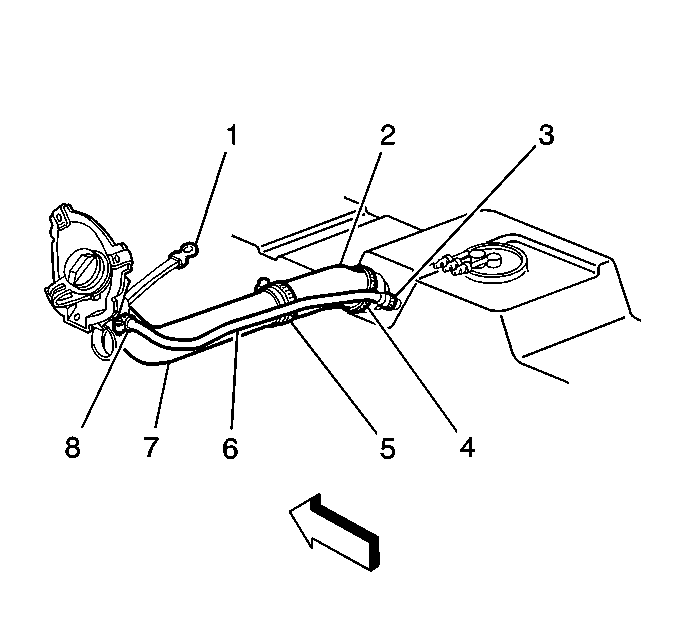
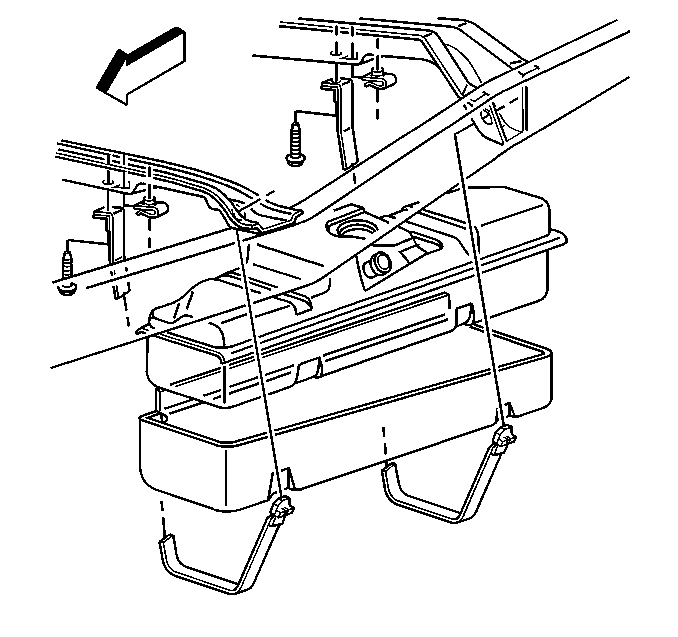
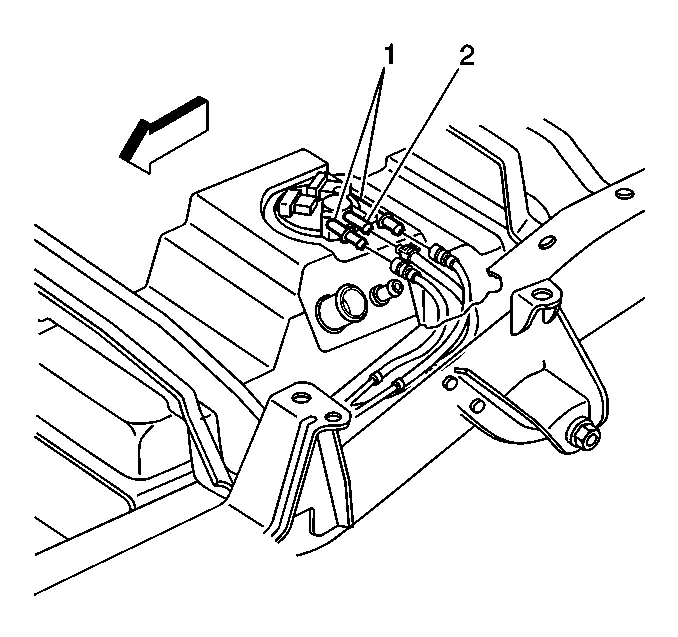
Installation Procedure
- Install the fuel tank insulators.
- Install the fuel sender. Refer to Fuel Sender Assembly Replacement .
- Raise the fuel tank.
- Connect the fuel pipes (1) and the vapor pipe (2) at the sender.
- Connect the electrical connections at the sender.
- Raise the fuel tank and shield fully.
- Install the fuel tank straps and fastening hardware.
- Connect the fuel tank filler neck hose (2) to the fuel tank.
- Connect the fuel tank vent hose (3) to the fuel tank.
- Lower the vehicle.
- Refill the fuel system.
- Install the fuel filler cap.
- Connect the negative battery cable.
- Inspect for fuel leaks.



Important: When removing or replacing the fuel tank, the fuel tank support fasteners should never be reused. Always use new fasteners when installing the fuel tank.
Notice: Use the correct fastener in the correct location. Replacement fasteners must be the correct part number for that application. Fasteners requiring replacement or fasteners requiring the use of thread locking compound or sealant are identified in the service procedure. Do not use paints, lubricants, or corrosion inhibitors on fasteners or fastener joint surfaces unless specified. These coatings affect fastener torque and joint clamping force and may damage the fastener. Use the correct tightening sequence and specifications when installing fasteners in order to avoid damage to parts and systems.
Tighten
Tighten the fuel tank strap fasteners to 13 N·m (115 lb in.).

Tighten
Tighten the clamps to 2.5 N·m (22 lb in).
| 14.1. | Turn ON the ignition for 2 seconds. |
| 14.2. | Turn OFF the ignition for 10 seconds. |
| 14.3. | Turn ON the ignition. |
| 14.4. | Inspect for fuel leaks. |
Fuel Tank Replacement Extended Cab - Side Tank
Removal Procedure
Tools Required
| • | J 34730-1A Fuel Pressure Gauge |
| • | J 39765 Fuel Sender Lock Nut Wrench |
- Disconnect the negative battery cable.
- Relieve the fuel system pressure. Refer to Fuel Pressure Relief .
- Drain the fuel from the tank. Refer to Fuel Tank Draining .
- Raise the vehicle. Refer to Lifting and Jacking the Vehicle in General Information.
- Disconnect the fuel tank filler neck hose (2) from the fuel tank.
- Disconnect the fuel tank vent hose (3) from the fuel tank.
- Support the fuel tank.
- Remove the rear fuel tank strap.
- Remove the frame mounted bracket and front fuel tank strap.
- With the aid of an assistant, lower and support the fuel tank and shield. Lower the fuel tank shield and the fuel tank to access the top of the fuel tank.
- Clean all fuel pipe connections and surrounding areas before disconnecting the fuel pipes in order to avoid possible contamination of the fuel system.
- Disconnect the fuel pipes (1) and the vapor pipe (2). Refer to Plastic Collar Quick Connect Fitting Service or Metal Collar Quick Connect Fitting Service .
- Disconnect the electrical connections at the sender.
- Remove the fuel tank and shield.
- Remove the fuel sender. Refer to Fuel Sender Assembly Replacement .
Caution: Unless directed otherwise, the ignition and start switch must be in the OFF or LOCK position, and all electrical loads must be OFF before servicing any electrical component. Disconnect the negative battery cable to prevent an electrical spark should a tool or equipment come in contact with an exposed electrical terminal. Failure to follow these precautions may result in personal injury and/or damage to the vehicle or its components.
Caution: To avoid any vehicle damage, serious personal injury or death when major components are removed from the vehicle and the vehicle is supported by a hoist, support the vehicle with jack stands at the opposite end from which the components are being removed and strap the vehicle to the hoist.

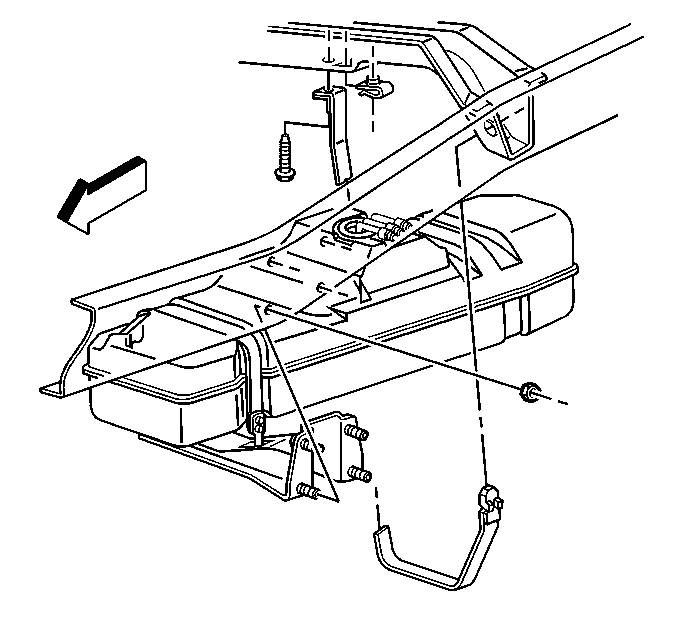
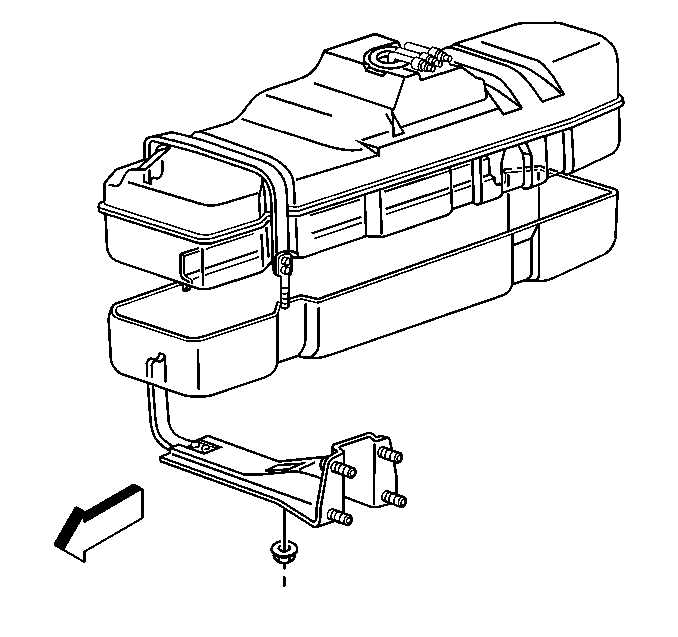
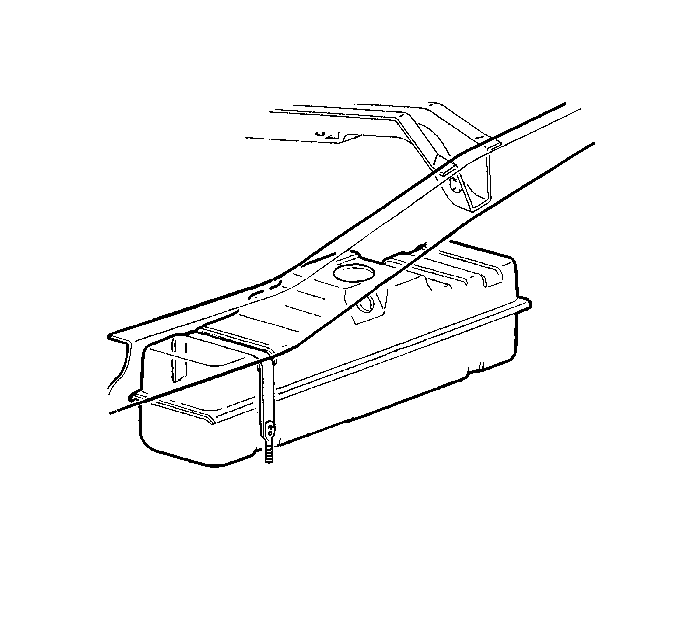

Installation Procedure
- Install the fuel tank insulators.
- Install the fuel sender. Refer to Fuel Sender Assembly Replacement .
- Raise the fuel tank.
- Connect the fuel pipes (1) and the vapor pipe (2) at the sender.
- Connect the electrical connections at the sender.
- Raise the fuel tank and shield fully.
- Install the front fuel tank strap and the frame mounted bracket.
- Install the rear fuel tank strap.
- Connect the fuel tank filler neck hose (2) to the fuel tank.
- Connect the fuel tank vent hose (3) to the fuel tank.
- Lower the vehicle.
- Refill the fuel system.
- Install the fuel filler cap.
- Connect the negative battery cable.
- Inspect for fuel leaks.



Important: When removing or replacing the fuel tank, the fuel tank support fasteners should never be reused. Always use new fasteners when installing the fuel tank.
Notice: Use the correct fastener in the correct location. Replacement fasteners must be the correct part number for that application. Fasteners requiring replacement or fasteners requiring the use of thread locking compound or sealant are identified in the service procedure. Do not use paints, lubricants, or corrosion inhibitors on fasteners or fastener joint surfaces unless specified. These coatings affect fastener torque and joint clamping force and may damage the fastener. Use the correct tightening sequence and specifications when installing fasteners in order to avoid damage to parts and systems.
Tighten
| • | Tighten the front strap nut to 13 N·m (115 lb in.). |
| • | Tighten the frame mounted bracket nuts to 33 N·m (24 lb ft). |

Tighten
Tighten the rear strap bolt to 13 N·m (115 lb in.).

Tighten
Tighten the clamps to 2.5 N·m (22 lb in.).
| 15.1. | Turn ON the ignition for 2 seconds. |
| 15.2. | Turn OFF the ignition for 10 seconds. |
| 15.3. | Turn ON the ignition. |
| 15.4. | Inspect for fuel leaks. |
Fuel Tank Replacement Cab and Chassis - Rear Tank
Removal Procedure
- Disconnect the negative battery cable.
- Relieve the fuel system pressure. Refer to Fuel Pressure Relief .
- Drain the fuel from the tank. Refer to Fuel Tank Draining .
- Raise the vehicle. Refer to Lifting and Jacking the Vehicle in General Information.
- Remove the fuel tank shield.
- Disconnect the filler neck hose and the vent hose at the fuel filler tube.
- Support the fuel tank.
- Remove the fuel tank straps.
- With the aid of an assistant, lower and support the fuel tank. Lower the fuel tank to access the top of the fuel tank.
- Clean all fuel pipe connections and surrounding areas before disconnecting the fuel pipes in order to avoid possible contamination of the fuel system.
- Disconnect the fuel pipes and the vapor pipe. Refer to Plastic Collar Quick Connect Fitting Service or Metal Collar Quick Connect Fitting Service .
- Disconnect the electrical connections at the sender.
- Remove the fuel tank.
- Remove the fuel sender. Refer to Fuel Sender Assembly Replacement .
Caution: Unless directed otherwise, the ignition and start switch must be in the OFF or LOCK position, and all electrical loads must be OFF before servicing any electrical component. Disconnect the negative battery cable to prevent an electrical spark should a tool or equipment come in contact with an exposed electrical terminal. Failure to follow these precautions may result in personal injury and/or damage to the vehicle or its components.
Caution: To avoid any vehicle damage, serious personal injury or death when major components are removed from the vehicle and the vehicle is supported by a hoist, support the vehicle with jack stands at the opposite end from which the components are being removed and strap the vehicle to the hoist.
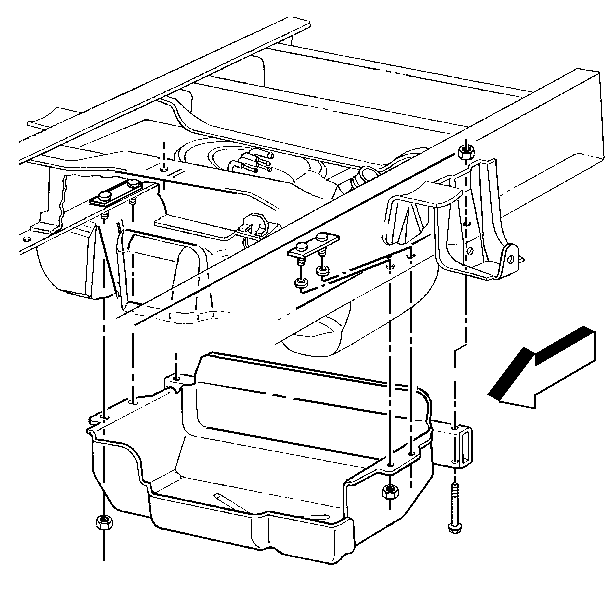
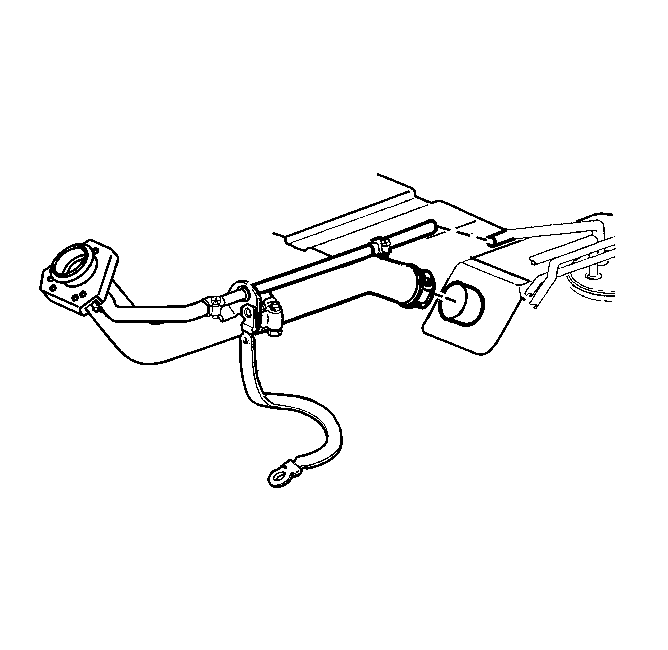
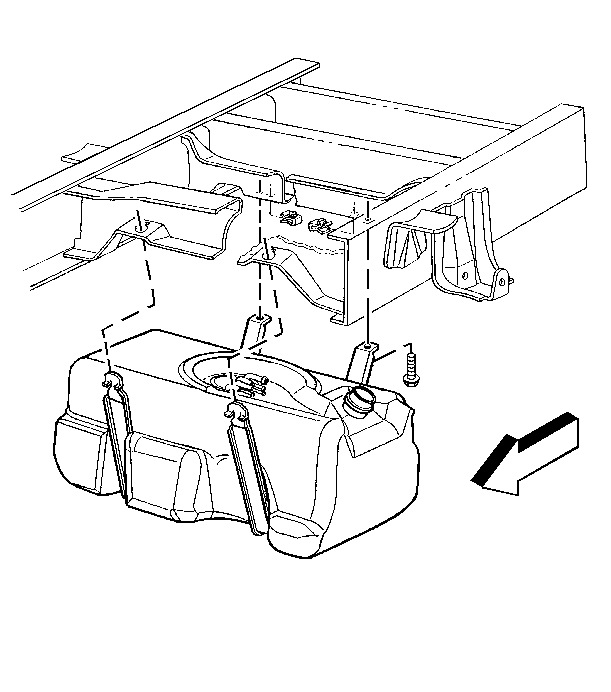

Installation Procedure
- Install the fuel sender. Refer to Fuel Sender Assembly Replacement .
- Raise the fuel tank.
- Connect the fuel pipes and the vapor pipe at the sender.
- Connect the electrical connections at the sender.
- Raise the fuel tank fully.
- Install the fuel tank straps and fastening hardware.
- Install the fuel tank shield.
- Connect the filler neck hose and the vent hose to the fuel filler tube.
- Lower the vehicle.
- Refill the fuel system.
- Install the fuel filler cap.
- Connect the negative battery cable.
- Inspect for fuel leaks.


Notice: Use the correct fastener in the correct location. Replacement fasteners must be the correct part number for that application. Fasteners requiring replacement or fasteners requiring the use of thread locking compound or sealant are identified in the service procedure. Do not use paints, lubricants, or corrosion inhibitors on fasteners or fastener joint surfaces unless specified. These coatings affect fastener torque and joint clamping force and may damage the fastener. Use the correct tightening sequence and specifications when installing fasteners in order to avoid damage to parts and systems.
Important: When removing or replacing the fuel tank, the fuel tank support fasteners should never be reused. Always use new fasteners when installing the fuel tank.
Tighten
Tighten the strap bolts to 35 N·m (26 lb ft).

Tighten
Tighten the fuel tank shield fastening hardware to 75 N·m
(55 lb ft).

Tighten
Tighten the clamps to 2.5 N·m (22 lb in.).
| 13.1. | Turn ON the ignition for 2 seconds. |
| 13.2. | Turn OFF the ignition for 10 seconds. |
| 13.3. | Turn ON the ignition. |
| 13.4. | Inspect for fuel leaks. |
Fuel Tank Replacement 4-Door Utility
Removal Procedure
- Disconnect the negative battery cable.
- Relieve the fuel system pressure. Refer to Fuel Pressure Relief .
- Drain the fuel from the fuel tank. Refer to Fuel Tank Draining .
- Raise the vehicle. Refer to Lifting and Jacking the Vehicle in General Information. This must be done with a frame hoist to allow the rear suspension to hang.
- Disconnect the fuel filler hose (7) and the vent hose (8) from the fuel tank.
- Support the fuel tank.
- Remove the fuel tank straps.
- With the aid of an assistant, lower and support the fuel tank and shield. Lower the fuel tank shield and the fuel tank to access the top of the fuel tank.
- Clean all fuel pipe connections and surrounding areas before disconnecting the fuel pipes in order to avoid possible contamination of the fuel system.
- Disconnect the fuel pipes (1) at the fuel sender (2). Refer to Plastic Collar Quick Connect Fitting Service or Metal Collar Quick Connect Fitting Service .
- Disconnect the electrical connectors at the sender.
- Disconnect the EVAP pipe at the roll over valve pipe.
- Remove the fuel tank.
- Remove the fuel sender. Refer to Fuel Sender Assembly Replacement .
Caution: Unless directed otherwise, the ignition and start switch must be in the OFF or LOCK position, and all electrical loads must be OFF before servicing any electrical component. Disconnect the negative battery cable to prevent an electrical spark should a tool or equipment come in contact with an exposed electrical terminal. Failure to follow these precautions may result in personal injury and/or damage to the vehicle or its components.
Caution: To avoid any vehicle damage, serious personal injury or death when major components are removed from the vehicle and the vehicle is supported by a hoist, support the vehicle with jack stands at the opposite end from which the components are being removed and strap the vehicle to the hoist.
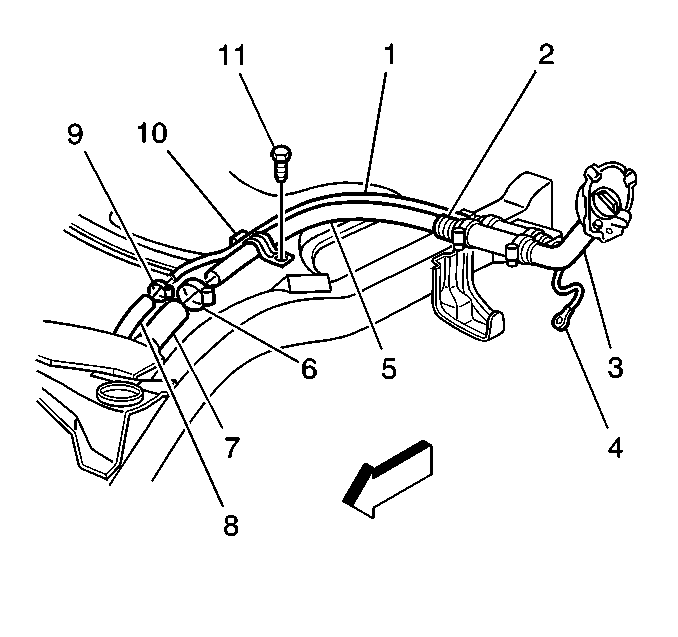
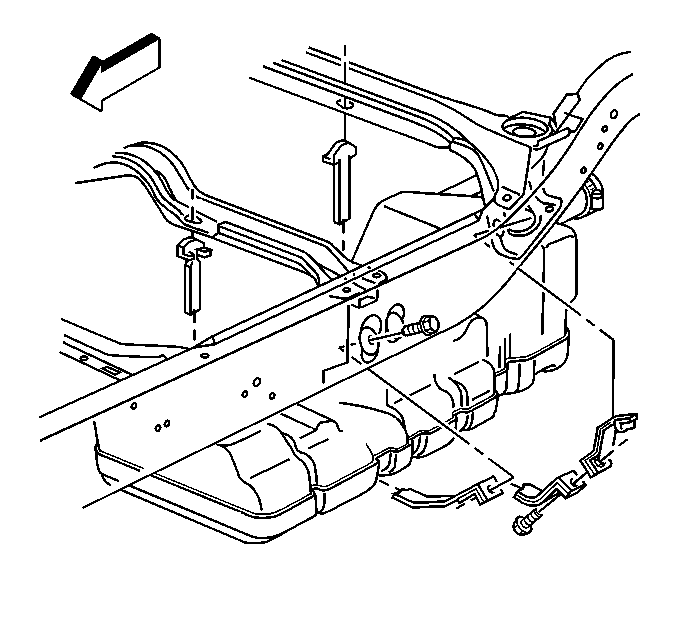
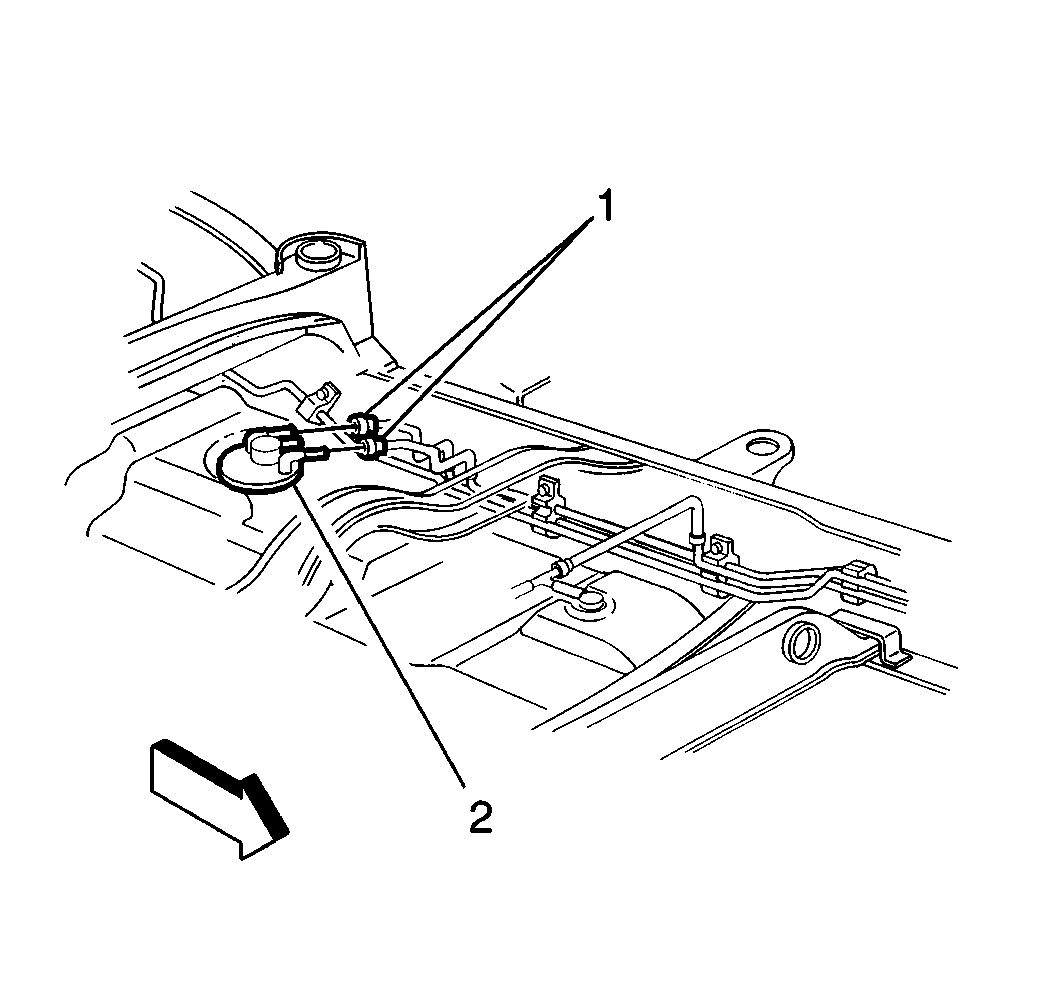
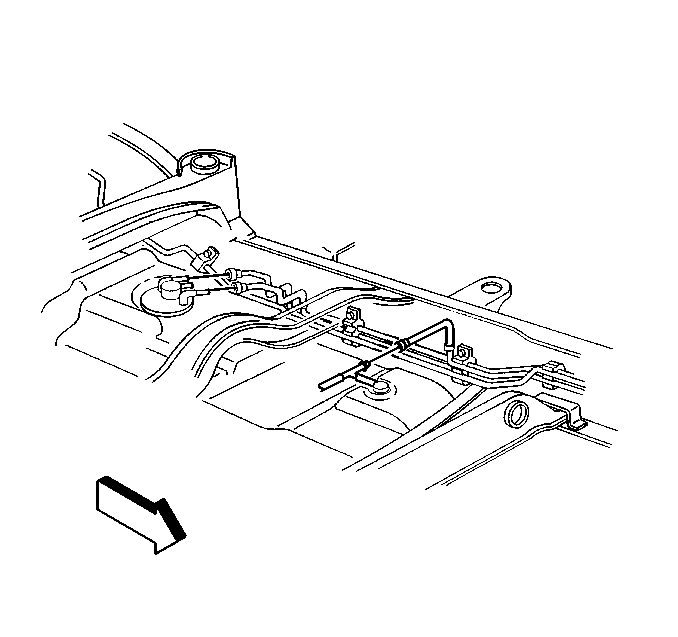

Installation Procedure
- Install the fuel sender. Refer to Fuel Sender Assembly Replacement .
- Raise the fuel tank.
- Connect the fuel pipes (1) at the fuel sender (2).
- Connect the EVAP pipe at the roll over valve pipe.
- Connect the fuel sender electrical connectors.
- Raise the fuel tank and shield fully.
- Install the fuel tank straps.
- Connect the fuel filler hose (7) and the vent hose (8) to the fuel tank.
- Lower the vehicle.
- Refill the fuel system.
- Install the fuel filler cap.
- Connect the negative battery cable.
- Inspect for fuel leaks.

Important: When removing or replacing the fuel tank, the fuel tank support fasteners should never be reused. Always use new fasteners when installing the fuel tank.



Notice: Use the correct fastener in the correct location. Replacement fasteners must be the correct part number for that application. Fasteners requiring replacement or fasteners requiring the use of thread locking compound or sealant are identified in the service procedure. Do not use paints, lubricants, or corrosion inhibitors on fasteners or fastener joint surfaces unless specified. These coatings affect fastener torque and joint clamping force and may damage the fastener. Use the correct tightening sequence and specifications when installing fasteners in order to avoid damage to parts and systems.
Tighten
Tighten the bolts to 35 N·m (26 lb ft).

Tighten
Tighten the clamps to 2.5 N·m (22 lb in.).
| 13.1. | Turn ON the ignition for 2 seconds. |
| 13.2. | Turn OFF the ignition for 10 seconds. |
| 13.3. | Turn ON the ignition. |
| 13.4. | Inspect for fuel leaks. |
Fuel Tank Replacement Cab and Chassis - Side Tank
Removal Procedure
- Disconnect the negative battery cable.
- Relieve the fuel system pressure. Refer to Fuel Pressure Relief .
- Drain the fuel from the tank. Refer to Fuel Tank Draining .
- Raise the vehicle. Refer to Lifting and Jacking the Vehicle in General Information.
- Disconnect the filler neck hose and the vent hose at the fuel filler tube.
- Support the fuel tank.
- Remove the fuel tank straps.
- With the aid of an assistant, lower and support the fuel tank and shield. Lower the fuel tank shield and the fuel tank to access the top of the fuel tank.
- Clean all fuel pipe connections and surrounding areas before disconnecting the fuel pipes in order to avoid possible contamination of the fuel system.
- Disconnect the fuel pipes (1,3) and the vapor pipe (2). Refer to Plastic Collar Quick Connect Fitting Service or Metal Collar Quick Connect Fitting Service .
- Disconnect the electrical connections at the sender.
- Remove the fuel tank and shield.
- Remove the fuel sender. Refer to Fuel Sender Assembly Replacement .
Caution: Unless directed otherwise, the ignition and start switch must be in the OFF or LOCK position, and all electrical loads must be OFF before servicing any electrical component. Disconnect the negative battery cable to prevent an electrical spark should a tool or equipment come in contact with an exposed electrical terminal. Failure to follow these precautions may result in personal injury and/or damage to the vehicle or its components.
Caution: To avoid any vehicle damage, serious personal injury or death when major components are removed from the vehicle and the vehicle is supported by a hoist, support the vehicle with jack stands at the opposite end from which the components are being removed and strap the vehicle to the hoist.

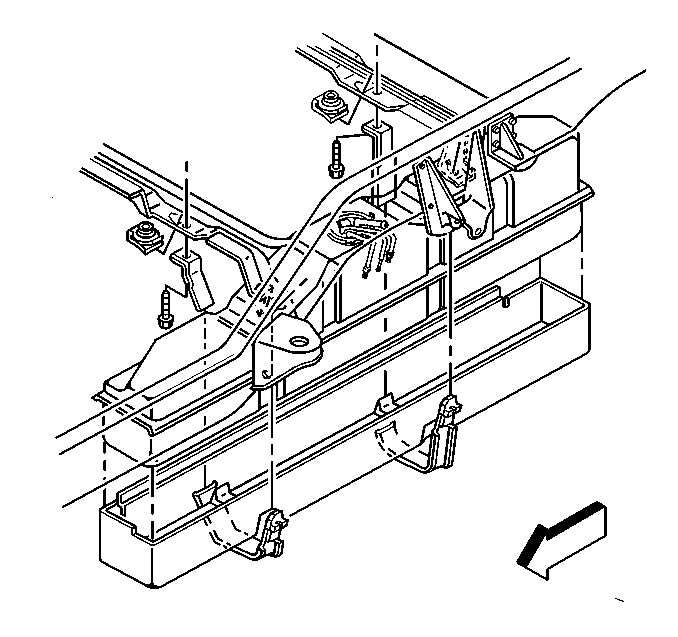

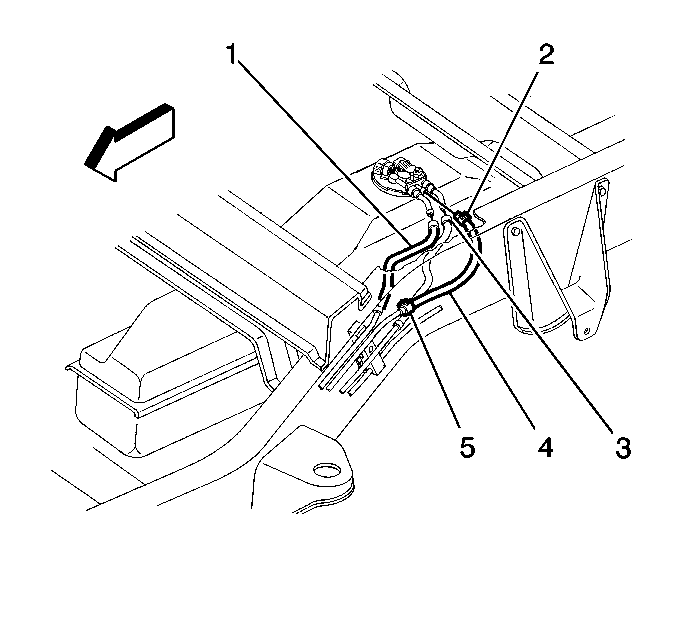
Installation Procedure
- Install the fuel tank insulators.
- Install the fuel sender. Refer to Fuel Sender Assembly Replacement .
- Raise the fuel tank.
- Connect the fuel pipes (1,3) and the vapor pipe (2) to the fuel sender.
- Connect the electrical connections at the sender.
- Raise the fuel tank and shield fully.
- Install the fuel tank straps.
- Connect the filler neck hose and the vent hose to the fuel filler tube.
- Lower the vehicle.
- Refill the fuel system.
- Install the fuel filler cap.
- Connect the negative battery cable.
- Inspect for fuel leaks.
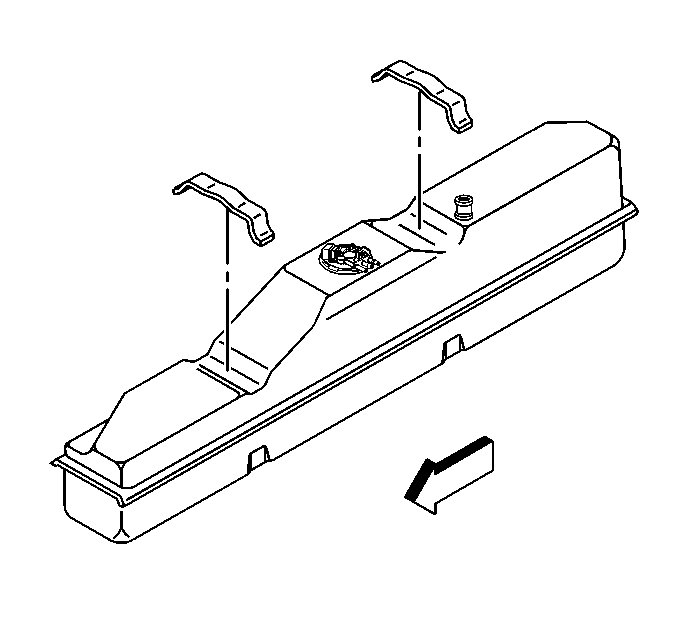



Notice: Use the correct fastener in the correct location. Replacement fasteners must be the correct part number for that application. Fasteners requiring replacement or fasteners requiring the use of thread locking compound or sealant are identified in the service procedure. Do not use paints, lubricants, or corrosion inhibitors on fasteners or fastener joint surfaces unless specified. These coatings affect fastener torque and joint clamping force and may damage the fastener. Use the correct tightening sequence and specifications when installing fasteners in order to avoid damage to parts and systems.
Important: When removing or replacing the fuel tank, the fuel tank support fasteners should never be reused. Always use new fasteners when installing the fuel tank.
Tighten
Tighten the strap bolts to 13 N·m (115 lb in.).
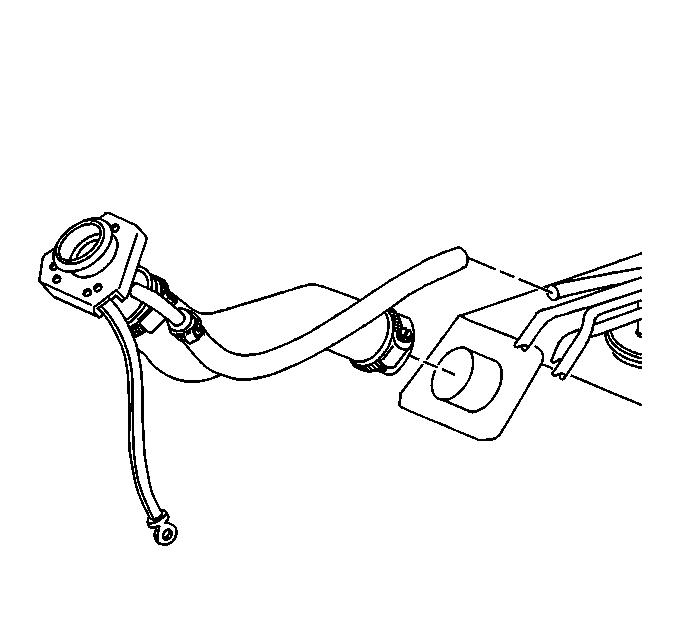
Tighten
Tighten the clamps to 2.5 N·m (22 lb in.).
| 13.1. | Turn ON the ignition for 2 seconds. |
| 13.2. | Turn OFF the ignition for 10 seconds. |
| 13.3. | Turn ON the ignition. |
| 13.4. | Inspect for fuel leaks. |
